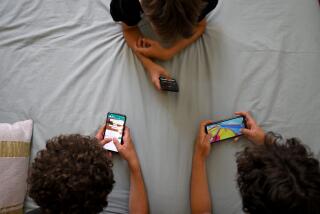Cellphone shields and brain cancer
- Share via
In the short time they’ve been around, cellphones have changed the world. Just 20 years ago -- if you can believe it -- you had to discuss dinner plans before you arrived at the grocery store. And just 20 years ago, you didn’t have to field work calls until you were actually at work.
Cellphones gave us new ways to stay connected. For some, they also provided a new reason for worry. Cellphones release microwave radiation when they’re in use, a fact that inevitably led to fears of brain cancer.
Just as inevitably, worries about brain cancer spawned a market for products that supposedly protect cellphone users. For $62, you can order a Delta Shield, a thin polyester patch that contains a microchip that allegedly renders cellphones harmless. Users are instructed to place the patch on their cellphone battery. The similar BIOPRO Cell Chip, sold online for $35, attaches to the outside of the phone. The penny-sized WaveShield 2000 Gold, selling for about $25, fits on the earpiece.
The claims: The website for the Delta Shield claims that it is “the only cellphone protection device that has proven efficacy.” An unpublished scientific paper highlighted on the site supposedly shows that the device can convert harmful delta brain waves to helpful alpha waves.
One site selling the BIOPRO Cell Chip site says its patented technology “has been proven in numerous scientific studies to neutralize the dangers of electromagnetic radiation from cellphones and other devices.” The site goes on to explain that the device “superimposes a low-frequency ‘noise field’ on EMR [electromagnetic radiation] that resembles the natural resonant frequencies of the body’s living cells. This effectively renders EMR harmless.”
The site for the WaveShield 2000 Gold claims that the device can reduce radiation from the earpiece by “50-97%.” The company used to claim that similar devices blocked up to 99% of radiation coming from the antenna -- the major source of cellphone radiation -- until the FTC filed suit for false advertising in 2002.
The bottom line: “Most [experts] think these devices are worthless,” says Richard Kaye, a former San Diego-based chiropractor and a Delta Shield business consultant. Though he is convinced the product works -- for one thing, he says, the side of his head no longer gets warm when he uses his cellphone -- two independent experts did, indeed, reach the opposite conclusion.
“It’s a scam,” says Robert Park, professor emeritus of physics at the University of Maryland and author of “Voodoo Science: The Road from Foolishness to Fraud,” published in 2000. “The claims they’re making aren’t very clear, but they are certainly wrong,” he says. “I’d stake my reputation on it, such as it is.”
Claims of “natural resonant frequencies” may seem impressive, but Park says: “People have been talking about natural resonant frequencies for years, but I still don’t know what that is. It’s a meaningless statement.” He adds that the cheap devices are extremely unlikely to possess the type of technology it would take to really absorb, deflect or modify radiation in any meaningful way. He notes that radar jamming systems on stealth bombers have that sort of capability. A gadget that you can slap on your cellphone? Probably not.
Dr. Ronald Herberman, director of the University of Pittsburgh Cancer Institute and one of the leading voices calling for caution with cellphones, says he is “not aware of any evidence supporting the claims of cellphone guards” and doesn’t recommend their use.
He and colleagues recently offered 10 tips for reducing radiation exposure from cellphones, including holding them as far away from the head as possible, using them for only a few minutes at a time and keeping them away from children. Cellphone shields didn’t warrant a mention.
Shield or no shield, the hazards of cellphones are far from certain. Park, for one, believes that the microwaves released by cellphones don’t have enough energy to break apart strands of DNA, the type of damage that could possibly set the stage for cancer. Herberman agrees that cellphone radiation “cannot directly damage DNA,” but he also thinks that cellphone radiation could still indirectly scramble genetic material in ways that have yet to be explained.
Findings on safety so far have been mixed. Researchers at the University of Utah recently pooled together the results of nine studies that looked for a link between cellphone use and brain cancer. As reported in the Journal of Neuro-Oncology in 2008, they found no sign that frequent cellphone users were more likely than anyone else to get brain cancer. A Danish study of more than 420,000 people also found no connection between cellphones and cancer, even in people who had used the phones for more than 10 years.
However, Australian researchers who examined 11 previous studies comparing people with and without brain tumors concluded that using a cellphone for more than 10 years more than doubled the risk of developing a brain tumor on the side of the head where a person usually used the phone. (It’s worth noting that some of the individual studies that they looked at concluded that cellphones didn’t raise cancer risk.)
In the face of that uncertainty, Herberman urges caution. That’s caution -- not cellphone shields.
--
Curious about a health product? Send an e-mail health@latimes.com. Read more at latimes.com/skeptic.






